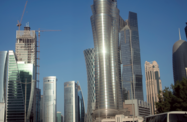A bid by Qatar’s government to consolidate several years of economic expansion, while channelling a budgetary surplus towards large-scale capital works projects, helped the country achieve its aim of more moderate growth for 2012.
Yousuf Hussein Kamal, the minister of economy and finance, said in December the government expected GDP growth to ease to 5.4% by the end of the year, falling further to 5% in 2013 and beyond. The estimates are down significantly on figures from 2011 when Qatar’s economy expanded by 14.8%. The minister, who was speaking at a finance conference in Doha, added that forecasts were in line with plans to achieve and maintain fiscal stability, while also focusing on diversifying the economy.
Estimates from the IMF are in keeping with government projections, with the organisation forecasting expansion of 4.9% in 2013. The IMF also expects the oil and gas sector’s contribution to remain flat.
In a recent note, ratings agency Fitch said it also expected Qatar’s GDP growth to ease further in 2013. The agency added that with gas production having now reached the government’s target, economic expansion was set to fall to mid-range single digits, while ongoing high capital spending by the state would maintain growth for the non-energy sector.
Energy production began levelling off at the end of 2010 when gas output reached the government’s annual target of 77m tonnes, although additional flow boosted GDP in 2011. For the first time since the middle of the last decade, Qatar decided against embarking on new production or adding processing capacity in 2012. However, the country still holds sizeable untapped fields that the government is keeping in reserve.
The banking sector ended 2012 on a high, with end-October deposits up 21% to QR348bn ($95.6bn). The combined assets of lenders also rose to QR800.6bn ($219.9bn), marking a year-on-year (y-o-y) increase of 22%, according to central bank data issued in December.
Banks’ lending activity was even stronger, with credit and financing portfolios expanding by 26% at the end of October to reach QR485bn ($133.3bn), of which all but QR29.86bn ($8.2bn) went to local borrowers. Increased lending to the local economy is expected to help the government achieve its key objective of maintaining private sector growth this year.
Although still at an early stage, the infrastructure programme, which has been valued at $130bn by the General Secretariat for Development Planning (GSDP), is earmarked for a major role in boosting private sector participation. The initiative is set to offer extensive opportunities across the sectors to investors until at least 2019, with construction, engineering, finance, technical services and logistics firms among those set to benefit.
Winning the right to host the World Cup helped accelerate Qatar’s long-term infrastructure development programme, which includes a metro and light rail system, railways linking to a regional network, and improvements to the road system. It has also added momentum to the ongoing expansion of hotel capacity. Despite the large-scale spending plans, ratings agency Standard & Poor’s (S&P) still expects the country to post a healthy surplus equivalent to 6% of GDP in 2012 through to 2015, on the back of continuing strong performance and ongoing solid growth.
In November, S&P assigned an AA/Stable/A-1+ sovereign credit rating to Qatar following its positive forecast, combined with what it described as strong external and fiscal balance sheets. The S&P rating followed a positive assessment from Moody’s, which in September rated Qatar’s long-term bonds at AA2 with a stable outlook.
Despite years of rapid economic expansion, close monitoring of Qatar’s monetary supply by the central bank has resulted in a check on inflation. Figures show it was running at a moderate 2% towards the end of 2012, with any dent made on the economy’s gains for the year largely insignificant.
Although the government has increased its projected oil price by $10 to $65 per barrel in its 2012-13 budgetary cycle, the estimate remains well below current and expected global rates. As such, the country will still almost certainly be able to fund its investment programme in 2013 without having to dip into reserves, even if international energy prices drop unexpectedly. Prospects for the Qatari economy in the coming year therefore look bright.

